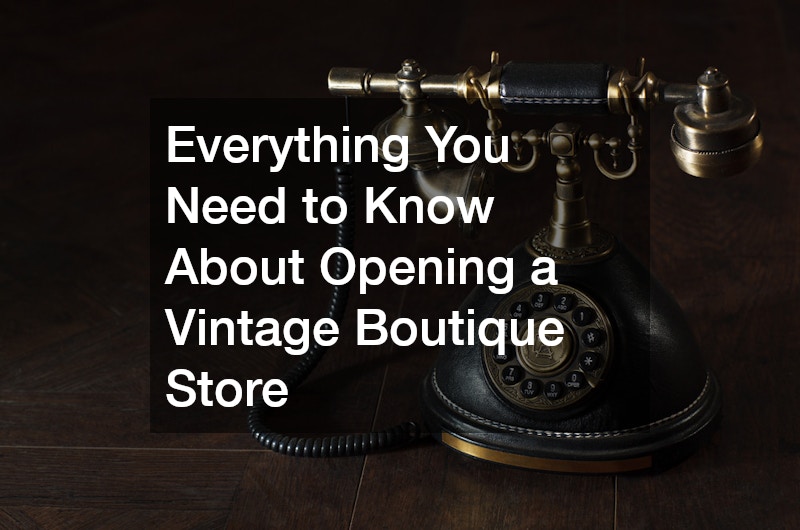Opening a vintage boutique store is a unique and exciting business venture that allows you to bring timeless pieces and nostalgic charm to your community. Unlike traditional retail stores, a vintage boutique requires a carefully curated collection, a deep understanding of past trends, and an eye for quality and authenticity. Whether you’re drawn to mid-century fashion, retro furniture, or antique accessories, starting a boutique that caters to vintage enthusiasts is as much about passion as it is about business strategy.
In this article, we’ll guide you through the essentials of opening your own vintage boutique—from researching the market to selecting the perfect location, creating a memorable brand, and sourcing unique inventory. You’ll discover tips on store design, pricing, and marketing that will help you appeal to both dedicated collectors and new customers looking to explore the world of vintage. We’ll also cover the practical aspects, like setting up your inventory system and understanding legal requirements, to ensure your store’s success. So, if you’re ready to turn your love for vintage into a thriving boutique business, keep reading for everything you need to know to bring your vision to life.

Researching the Vintage Market
Researching the vintage market is a crucial first step for anyone interested in opening a vintage boutique. The demand for vintage fashion continues to evolve, driven by trends, nostalgia, and the pursuit of unique apparel. By understanding the vintage landscape, aspiring boutique owners can tailor their offerings to meet particular market niches.
Understanding the financial aspect is equally important, and exploring small business loans can provide the necessary capital. These loans can offer financial assistance to cover initial startup costs such as renting a space, purchasing vintage inventory, and marketing the business. With a clear vision and adequate financing, the foundation for a successful small business is laid.
Market research not only informs inventory choices but also shapes branding strategies. Identifying competitors and analyzing their tactics, such as pricing strategies and customer service, gives new boutique owners valuable insights. Combining this with the financial support from small business loans, entrepreneurs can strategically enter the vintage market with confidence.
Choosing the Right Location
Choosing the right location when opening a vintage boutique is a decisive factor in its success. Look for areas with high foot traffic, such as urban centers or trendy neighborhoods, which can significantly increase visibility and walk-in customers. The right location sets the foundation for building a loyal customer base seeking unique vintage finds.
In addition to foot traffic, consider practical aspects like proximity to transportation and parking facilities. The condition of the premises may require attention, involving services such as a flooring service to restore or enhance the boutique’s aesthetics. Investing in fire suppression software is also necessary to protect the inventory from unforeseen accidents.
Lastly, assess the local competition in the area. Understanding the existing retail landscape ensures that your vintage boutique offers something distinct and valuable. This strategic location choice, combined with amenities like a flooring service for aesthetic enhancement and fire suppression software for safety, can lead to long-term success.
Renovating Your Commercial Space
Once the perfect location is chosen when opening a vintage boutique, renovating the commercial space becomes the next priority. During this phase, addressing any past issues is crucial, necessitating the engagement of commercial water damage repair companies to ensure the property is in pristine condition. Repairing water damage is a foundational step to creating a welcoming and safe shopping environment.
The ambiance of your boutique can be significantly enhanced by choosing quality materials from a natural stone supplier. Natural stone not only offers durability but also adds an elegant touch to the décor, particularly for countertops and display areas. The right materials can influence the overall shopping experience, enticing customers to explore the store further.
Each aspect of the store must contribute to a cohesive brand image. Design should marry aesthetics with functionality, ensuring that the layout is both pleasing to the eye and convenient for customer navigation. With careful planning and collaboration with professionals like commercial water damage repair companies and a natural stone supplier, the boutique becomes a destination for vintage enthusiasts.

Creating Your Brand Identity
Creating a brand identity is an essential process that goes beyond a logo or business name when opening a vintage boutique. It involves developing a narrative and personality that resonates with your target audience. A well-defined brand identity sets your vintage boutique apart from competitors and establishes an emotional connection with customers.
Your brand story could highlight the uniqueness of the vintage pieces you offer, why you chose to enter the vintage market, or the value you place on sustainability through fashion. This narrative will guide your marketing efforts and influence how customers perceive your boutique. Consistency across all platforms and interactions strengthens your brand’s presence and reputation in the market.
From visual elements like store design and packaging to customer service approaches, every aspect should align with the brand identity. Offering exceptional customer experiences further reinforces the brand’s image and leaves a lasting impression. In a competitive retail landscape, a memorable brand identity can become a key factor in customer loyalty and long-term success when opening a vintage boutique.
Sourcing Unique Vintage Pieces
Sourcing unique vintage pieces is both an art and a science, vital to the appeal of your boutique. Start by establishing strong relationships with vintage suppliers and attending estate sales, auctions, and flea markets. These venues offer opportunities to find distinctive items that will set your collection apart from others.
Consider working with a local embroidery company to customize certain pieces or create exclusive designs. This collaboration allows you to add a personal touch to your inventory, offering one-of-a-kind apparel that cannot be found elsewhere. Personalized or custom pieces often resonate well with customers seeking individuality in their fashion choices.
Understanding the preferences and style trends of your target market is essential when selecting pieces for your boutique. Regularly updating your inventory with fresh finds keeps customers coming back to discover what’s new. A diverse, well-curated collection that reflects both quality and novelty can significantly boost the boutique’s reputation and customer appeal.
Setting Up an Inventory System
Efficient inventory management is crucial for smooth operation when opening a vintage boutique. Implementing an inventory system helps track stock levels, manage orders, and identify sales patterns. This system ensures that popular items are restocked promptly, while slow-moving products are carefully assessed for future inventory decisions.
The choice of inventory software is vital, offering features that align with your business’s needs. Consider solutions that integrate well with your point-of-sale (POS) system and accounting software for seamless operations. A robust system can enhance decision-making processes, enabling data-driven insights into which products resonate most with your customers.
Regular audits are an essential part of maintaining an efficient inventory system. These checks ensure accuracy and help identify discrepancies early, minimizing loss and optimizing profits. Streamlining inventory processes allows boutique owners to focus on other critical aspects of their business, including marketing strategies and customer engagement.

Designing an Inviting Store Layout
The layout of your vintage boutique significantly impacts customer experience, making it crucial to design an inviting space. Start by installing commercial glass store fronts, which help create a welcoming, transparent view from the outside. These glass facades attract passersby, inviting them to explore the treasures within.
The interior layout should facilitate easy navigation, creating flow from one section to another without clutter or confusion. Integrating light upgrades can significantly enhance the ambiance and highlight key pieces, creating focal points within the store. Effective lighting not only enhances the display but also improves the overall shopping atmosphere.
Incorporate elements that reflect your vintage brand’s identity, whether through nostalgic decorations or contemporary fixtures with a retro twist. The choice of furniture and decor should complement the vintage theme, enhancing the storytelling aspect of your store layout. A thoughtfully designed space captivates customers, encouraging longer visits and increased sales when opening a vintage boutique.
Marketing Your Vintage Boutique
Marketing plays a pivotal role in establishing a vintage boutique’s presence. Start with online marketing strategies, such as a vibrant, user-friendly website and active social media profiles showcasing your inventory. Visual engagement empowers potential customers to experience the boutique’s charm even before visiting in person.
Offline marketing tactics can complement your digital efforts effectively. Installing a neon sign outside your store acts as an eye-catching landmark, enhancing visibility and drawing in curious shoppers. Participating in local events or fashion shows allows for networking opportunities and further promotes your vintage collection.
Engage with your community by hosting workshops or style sessions, establishing your boutique as a hub for fashion enthusiasts. Creating a personal connection with customers through both online and offline endeavors can significantly enhance brand loyalty. A comprehensive marketing plan ensures sustained growth and brand recognition when opening a vintage boutique.
Building a Loyal Customer Base
Building a loyal customer base requires a blend of exceptional service, unique products, and a memorable shopping experience. Personalize interactions to make customers feel valued, whether through personalized emails, birthday discounts, or offers based on previous purchases. Customer loyalty programs can also encourage repeat visits and increased spending.
Fostering a sense of community around your boutique is key. Hosting events, such as style workshops, fashion shows, or social gatherings, encourages interaction and engagement with your brand. Listening to customer feedback and continually improving your offerings based on their suggestions can help cultivate trust and satisfaction.
Successful loyalty programs not only reward customers but also collect useful data about their preferences and behaviors. This information enables you to fine-tune your marketing strategies and tailor your inventory to meet evolving demands. Strong customer relationships are the heart of long-term business success, turning casual shoppers into devoted brand advocates.

Pricing Strategies for Vintage Items
Pricing is a critical factor in maintaining profitability while appealing to your target market. When opening a vintage boutique, adopt a pricing strategy that reflects the quality and uniqueness of your vintage pieces, while also considering market trends and competition. Balancing fair pricing with profitability ensures long-term success.
Conducting regular market analysis provides valuable insights into competitive pricing and helps assess customer willingness to pay. Consider adopting tiered pricing models that provide options for different budget levels while maintaining value. Clear pricing displays and transparency are vital in building trust and encouraging purchases.
Experiment with promotional offers, such as limited-time discounts or bundle deals, to boost sales and attract more customers. Continuous evaluation of pricing strategies ensures that your boutique remains relevant and competitive in the dynamic vintage market. Well-structured pricing reflects both the allure and authenticity of your vintage inventory.
Starting a vintage boutique store is a rewarding journey that combines passion with a strategic approach to business. By carefully curating your inventory, understanding your market, and building a unique brand, you can create a shopping experience that resonates with customers who appreciate the charm of past eras. Sourcing quality vintage items, creating an inviting store layout, and setting the right price points will help you stand out in a competitive market, attracting both collectors and newcomers to vintage fashion and decor.
Remember, the success of opening a vintage boutique goes beyond the items you sell—it’s about the atmosphere, customer service, and the story you tell. Vintage shopping is as much about discovery and nostalgia as it is about style, so foster a space where customers feel inspired and connected to the items you offer. As you move forward, stay adaptable and open to learning, as trends and customer preferences can shift over time. With dedication and an eye for detail, your boutique can become a cherished part of the community. Now that you’re equipped with the knowledge and tools needed to open a vintage boutique store, it’s time to bring your vision to life and start sharing your love for vintage treasures.




